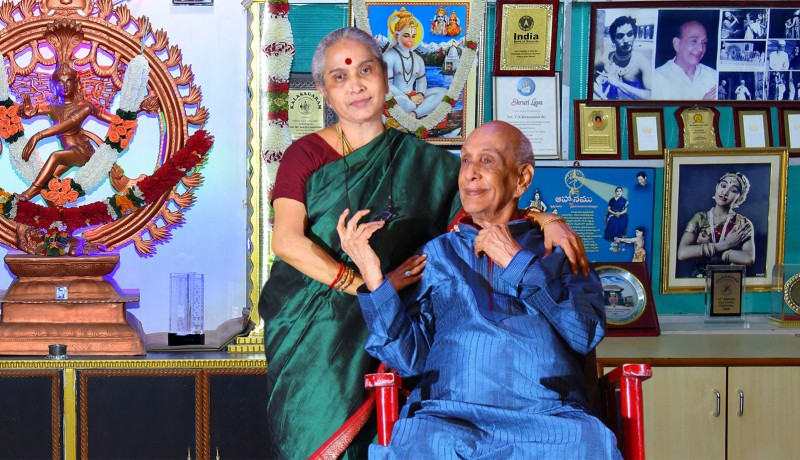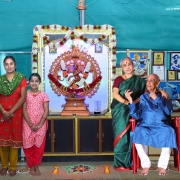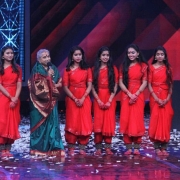
People

Manjula Ramaswamy of Hyderabad’s Rama Nataka Niketan and her troupe are putting a spin on Bharatanatyam, and winning awards, finds Shyamola Khanna
Just like many other performing arts, classical dance has succumbed to the lure of dance competitions, the razzle-dazzle of televised events, and the lucrative prizes these mega-shows bring. Manjula Ramaswamy, 60, is not one to swim against the tide.
Shouldering the mantle of her father V S Ramamoorthy, 97, at the Rama Nataka Niketan in Hyderabad, Ramaswamy is in a huddle with her troupe of seven young Bharatanatayam dancers. The girls, in glittering costumes, have just stepped down from the stage after their performance in an elimination round of Dance Plus, a dance competition that airs on a popular television channel. As the troupe danced their way into the top six, Ramaswamy, their guru, stayed on the sidelines, playing the nattuvangam, keeping count, eyeing the girls’ expressions and watching their every move.
After four months on stage, when they returned to Hyderabad in October, the girls headed straight to seek the blessings of Ramamoorthy, the grand old man of the dance academy, where they had taken their first steps into the world of Bharatanatayam years ago.
An academy of repute, it has trained 2,000-odd students for the last 50 years; conducted around 500 arangetrams, a graduation-like ceremony performed on the public stage for the first time; and its students have bagged accolades like the Balashri, a national-level award conferred by the President of India, and the Balaratna, an award given by the Andhra Pradesh government.
At age 97, the academy’s founder V S Ramamoorthy is hard of hearing but the one voice he hears loud and clear is that of his daughter. Ramaswamy has been his devoted student and assistant for 50 years, and is the driving force carrying forward his legacy. “For the next seven janma, I want you to be my daughter,” he often tells her.
We climb the stairs with Ramaswamy, a floor above her home, where the magic is created. Before entering the room, she touches the floor with her fingers and raises them to her forehead—a salute to a living dream!
The walls and floor are adorned with devotional artefacts while also serving as a tribute to Ramamoorthy. The large hall is virtually a chronicle of the dance avatars he donned in his time, and there are myriad picture frames and mementoes from performances all over the world.
Ramaswamy exudes abhinaya. Her eyes, fingers and hands all move in consonance with her words…but then she has been dancing since the age of eight. “Dance seeps into your mind, body and bloodstream till you begin to live and breathe only nritya,” she says.
Her father, a first-generation Bharatanatayam artist, trained under the renowned K N Dandayuthapani Pillai of Kalakshetra. “My grandparents were not happy at my father wanting to learn Bharatanatayam because it was not something boys did.”
Then only 20 years old, Ramamoorthy, a civil engineering graduate, had landed his first job at the Military Engineer Services (MES) in Avadi, near Chennai. He took the train to his dance school in Mylapore, 15 km away, after work. As he was the only male student, his was the last session of the day and the lad would catch the last train back at 10 pm.
The blood, sweat and tears paid off, for in 1947, Ramamoorthy had the honour of performing his arangatrem in the presence of Dr Rajendra Prasad, then President of India, and his own reluctant parents! “When my grandparents heard the applause, they joined in, smiling and clapping. My father told me it was the happiest moment of his life,” she smiles.
Ramamoorthy spent the next two decades juggling his transferable job, raising his family and his passion for dance. When he was in Perumbur, Chennai, 50 years ago, a colleague had asked him to teach his two little daughters Bharatanatayam. “My father, of course, was very willing,” says Ramaswamy.
This was the beginning of what would soon become the Sri Rama Nataka Niketan, which was then based in Secunderabad, the city of his last posting with MES. His little helper, eight year-old Manjula, began assisting him every step of the way. “My father is a strict disciplinarian and I could never say ‘no’ to him or my mother. When he went to take class, he would say, ‘Come on, Manju!’ I had to obey. It was my duty to sit and watch.”
The grand old man has since mellowed a lot. “Something came over him about 15 years ago, and over a period of time, I took over the reins. It was a natural transition… almost as if I just continued what I had been doing.” Yet, it is well known that for her, Appa is the gurushri. “If I am the body, my father is the soul of what we do.”
Ramaswamy was inducted into teaching long before she took her first steps as a dancer. When she was just eight, and one of the students was unable to do the adapu (a basic unit of the dance postures), her father asked her to demonstrate it.
“I had not learnt dance till then, but I instantly recognised the mistake and without any hesitation, I showed her the correct way,” says Ramaswamy, smiling at the recollection. Slowly, the father began nurturing and teaching the daughter.
“I used to admire the way my father would do the natuvangam (the rhythm recitation), wielding his cymbals without missing a beat,” recalls Ramaswamy, whose style of teaching couldn’t be more different from her father’s.
Her calm demeanour inspires confidence in her students, not least of whom is her older daughter, Ramya, 37, and her two granddaughters. “I was 14 years old when I started learning dance from my mother. Although I have not done my arangetram, I have passed all my exams and am a registered Grade A artist of Doordarshan,” says Ramya..
Ramaswamy has brought dance productions and ballets into the ambit of the school curriculum—tales from the epics are set to dance and rhythm, such as Godha Kalyanam, Sita Parinayam, Bhakta Ramadasa. Their stories are told through dance. “More than anything else, it is my spiritual strength that keeps me going. I am on the path of the Bhagvad-Gita; I am doing my duty and I shall carry on until my last breath,” she says.
The dancer dotes on her granddaughters Varsha, 12, and Vanshika, eight, both students of the academy, but she is every bit as strict about their education in dance. Varsha was a part of Dance Plus (Season 7), which aired on TV this year. The current season has concluded, with the school winning accolades—they were among the Top 6 teams. Earlier, at the India’s Got Talent show, they were semi-finalists.
As we walk around the studio, Vanshika comes up to speak to us. At present, she is the youngest dancer in the school. “Stand still and answer properly!” a stern voice calls out from inside. Vanshika’s posture changes; suddenly, she is all proper and correct! She names her two gurus: her great-grandfather (Gurushri Ramamurthy garu) and then her grandmother (Gurushrimati Manjula Ramaswamy garu). We move on from the topic but the young apprentice continues to hold her posture without flinching.
January 2018
you may also like to read
-
For the love of Sanskrit
During her 60s, if you had told Sushila A that she would be securing a doctorate in Sanskrit in the….
-
Style sensation
Meet Instagram star Moon Lin Cocking a snook at ageism, this nonagenarian Taiwanese woman is slaying street fashion like….
-
Beauty and her beast
Meet Instagram star Linda Rodin Most beauty and style influencers on Instagram hope to launch their beauty line someday…..
-
Cooking up a storm!
Meet Instagram star Shanthi Ramachandran In today’s web-fuelled world, you can now get recipes for your favourite dishes at….









